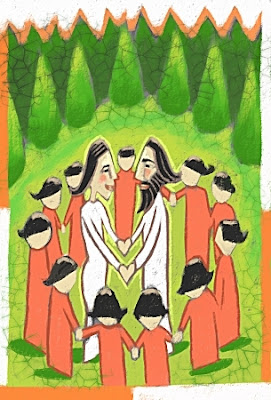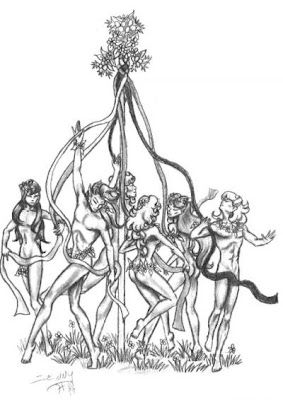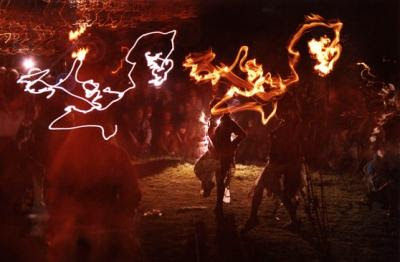 Beltane or Bealtaine (Irish, pronounced BEL- tayn ) is an ancient Gaelic holiday celebrated around May 1. Historically, this festival was celebrated in Ireland, Scotland and the Isle of Man. There were similar festivals held at the same time in the other Celtic countries of Wales and Brittany and the English county of Cornwall. The festival survives in folkloric practices in the Celtic Nations and the diaspora, and has experienced a degree of revival in recent decades.
Beltane or Bealtaine (Irish, pronounced BEL- tayn ) is an ancient Gaelic holiday celebrated around May 1. Historically, this festival was celebrated in Ireland, Scotland and the Isle of Man. There were similar festivals held at the same time in the other Celtic countries of Wales and Brittany and the English county of Cornwall. The festival survives in folkloric practices in the Celtic Nations and the diaspora, and has experienced a degree of revival in recent decades. For the Celts, Beltane marked the beginning of the pastoral summer season when the herds of livestock were driven out to the summer pastures and mountain grazing lands. In modern Irish, Mí na Bealtaine ('month of Bealtaine') is the name for the month of May. The name of the month is often abbreviated to Bealtaine, with the festival day itself being known as Lá Bealtaine. The lighting of bonfires on Oidhche Bhealtaine ('the eve of Bealtaine') on mountains and hills of ritual and political significance was one of the main activities of the festival.
For the Celts, Beltane marked the beginning of the pastoral summer season when the herds of livestock were driven out to the summer pastures and mountain grazing lands. In modern Irish, Mí na Bealtaine ('month of Bealtaine') is the name for the month of May. The name of the month is often abbreviated to Bealtaine, with the festival day itself being known as Lá Bealtaine. The lighting of bonfires on Oidhche Bhealtaine ('the eve of Bealtaine') on mountains and hills of ritual and political significance was one of the main activities of the festival. In ancient Ireland the main Bealtaine fire was held on the
In ancient Ireland the main Bealtaine fire was held on the  central hill of Uisneach 'the navel of Ireland', the ritual centre of the country, which is located in what is now County Westmeath. In Ireland the lighting of bonfires on Oidhche Bhealtaine seems only to have survived to the present day in parts of rural County Galway and County Limerick, especially in Limerick itself, as their yearly bonfire night, though some cultural groups have expressed an interest in reviving the custom at Uisneach and perhaps at the Hill of Tara. The lighting of a community Bealtaine fire from which individual hearth fires are then relit is also observed in modern times in some parts of the Celtic diaspora and by some Neopagan groups, though in the majority of these cases this practice is a cultural revival rather than an unbroken survival of the ancient tradition.
central hill of Uisneach 'the navel of Ireland', the ritual centre of the country, which is located in what is now County Westmeath. In Ireland the lighting of bonfires on Oidhche Bhealtaine seems only to have survived to the present day in parts of rural County Galway and County Limerick, especially in Limerick itself, as their yearly bonfire night, though some cultural groups have expressed an interest in reviving the custom at Uisneach and perhaps at the Hill of Tara. The lighting of a community Bealtaine fire from which individual hearth fires are then relit is also observed in modern times in some parts of the Celtic diaspora and by some Neopagan groups, though in the majority of these cases this practice is a cultural revival rather than an unbroken survival of the ancient tradition. Another common aspect of the festival which survived up until the early 20th century in Ireland was the hanging of May Boughs on the doors and windows of houses and of the erection of May Bushes in farmyards, which usually consisted either of a branch of rowan (mountain ash) or whitethorn (hawthorn) which is in bloom at the time and is commonly called the 'May Bush' in Hiberno-English. The practice of decorating the May Bush with flowers, ribbons, garlands and colored egg shells has survived to some extent among the diaspora as well, most notably in Newfoundland, and in some Easter traditions observed on the East Coast of the United States.
Another common aspect of the festival which survived up until the early 20th century in Ireland was the hanging of May Boughs on the doors and windows of houses and of the erection of May Bushes in farmyards, which usually consisted either of a branch of rowan (mountain ash) or whitethorn (hawthorn) which is in bloom at the time and is commonly called the 'May Bush' in Hiberno-English. The practice of decorating the May Bush with flowers, ribbons, garlands and colored egg shells has survived to some extent among the diaspora as well, most notably in Newfoundland, and in some Easter traditions observed on the East Coast of the United States. Beltane is a cross-quarter day, marking the midpoint in the Sun's progress between the vernal equinox and summer solstice. Since the Celtic year was based on both lunar and solar cycles, it is possible that the holiday was celebrated on the full moon nearest the midpoint between the vernal equinox and the summer solstice. The astronomical date for this midpoint is closer to May 5 or May 7, but this can vary from year to year.
Beltane is a cross-quarter day, marking the midpoint in the Sun's progress between the vernal equinox and summer solstice. Since the Celtic year was based on both lunar and solar cycles, it is possible that the holiday was celebrated on the full moon nearest the midpoint between the vernal equinox and the summer solstice. The astronomical date for this midpoint is closer to May 5 or May 7, but this can vary from year to year. In Irish mythology, the beginning of the summer season for the Tuatha Dé Danann and the Milesians started at Bealtaine. Great bonfires would mark a time of purification and transition, heralding in the season in the hope of a good harvest later in the year, and were accompanied with ritual acts to protect the people from any harm by Otherworldly spirits, such as the Sídhe. Like the festival of Samhain, opposite Beltane on Nov. 1st (note: the day before Samhain [pronounced Sow-win] (Samhain Eve) became Halloween), Beltane was a time when the Otherworld was seen as particularly close at hand. Early Gaelic sources from around the 10th century state that the druids of the community would create a need-fire on top of a hill on this day and drive the village's cattle through the fires to purify them and bring luck (Eadar dà theine Bhealltainn in Scottish Gaelic, 'Between two fires of Beltane'). In Scotland, boughs of juniper were sometimes thrown on the fires to add an additional element of purification and blessing to the smoke. People would also pass between the two fires to purify themselves. This was echoed throughout history after Christianization, with lay people instead of Druid priests creating the need-fire. The festival persisted widely up until the 1950s, and in some places the celebration of Beltane continues today. A revived Beltane Fire Festival has been held every year since 1988 during the night of 30 April on Calton Hill in Edinburgh, Scotland and attended by up to 15,000 people (except in 2003 when local council restrictions forced the organisers to hold a private event elsewhere).
In Irish mythology, the beginning of the summer season for the Tuatha Dé Danann and the Milesians started at Bealtaine. Great bonfires would mark a time of purification and transition, heralding in the season in the hope of a good harvest later in the year, and were accompanied with ritual acts to protect the people from any harm by Otherworldly spirits, such as the Sídhe. Like the festival of Samhain, opposite Beltane on Nov. 1st (note: the day before Samhain [pronounced Sow-win] (Samhain Eve) became Halloween), Beltane was a time when the Otherworld was seen as particularly close at hand. Early Gaelic sources from around the 10th century state that the druids of the community would create a need-fire on top of a hill on this day and drive the village's cattle through the fires to purify them and bring luck (Eadar dà theine Bhealltainn in Scottish Gaelic, 'Between two fires of Beltane'). In Scotland, boughs of juniper were sometimes thrown on the fires to add an additional element of purification and blessing to the smoke. People would also pass between the two fires to purify themselves. This was echoed throughout history after Christianization, with lay people instead of Druid priests creating the need-fire. The festival persisted widely up until the 1950s, and in some places the celebration of Beltane continues today. A revived Beltane Fire Festival has been held every year since 1988 during the night of 30 April on Calton Hill in Edinburgh, Scotland and attended by up to 15,000 people (except in 2003 when local council restrictions forced the organisers to hold a private event elsewhere). Beltane as described in this article is a specifically Gaelic holiday. Other Celtic cultures, such as the Welsh, Bretons, and Cornish, do not celebrate Beltane, per se. However they celebrated or celebrate festivals similar to it at the same time of year. In Wales, the day is known as Calan Mai, and the Gaulish name for the day is Belotenia.
Beltane as described in this article is a specifically Gaelic holiday. Other Celtic cultures, such as the Welsh, Bretons, and Cornish, do not celebrate Beltane, per se. However they celebrated or celebrate festivals similar to it at the same time of year. In Wales, the day is known as Calan Mai, and the Gaulish name for the day is Belotenia.Dwelly wrote:
“In many parts of the Highlands, the young folks of the district would meet on the moors on 1st May. They cut a table in the green sod, of a round figure, by cutting a trench in the ground of sufficient circumferences to hold the whole company. They then kindled a fire, dressed a repast of eggs and milk of the constituency of custard. They kneaded a cake of oatmeal, which was toasted at the embers against a stone. After the custard was eaten, they divided the cake into as many portions as there were people in the company, as much alike as possible in size and shape. They daubed one of the pieces with charcoal, til it was black all over, and they were then all put into a bonnet together, and each one blindfolded took out a portion. The bonnet holder was entitled to the last bit, and whoever drew the black bit was the person who was compelled to leap three times over the flames. Some people say this was originally to appease a god, whose favour they tried to implore by making the year productive." (Dwelly, 1911, "Bealltuinn")
 Beltane is observed by Neopagans in various forms, and by a
Beltane is observed by Neopagans in various forms, and by a  variety of names. As forms of Neopaganism can be quite different and have very different origins, these representations can vary considerably despite the shared name. Some celebrate in a manner as close as possible to how the Ancient Celts and Living Celtic cultures have maintained the traditions, while others observe the holiday with rituals culled from numerous other unrelated sources, Celtic culture being only one of the sources used.
variety of names. As forms of Neopaganism can be quite different and have very different origins, these representations can vary considerably despite the shared name. Some celebrate in a manner as close as possible to how the Ancient Celts and Living Celtic cultures have maintained the traditions, while others observe the holiday with rituals culled from numerous other unrelated sources, Celtic culture being only one of the sources used.Wiccans and Wiccan-inspired Neopagans celebrate a variation of Beltane as a sabbat, one of the eight solar holidays. Although the holiday may use features of the Gaelic Bealtaine, such as the bonfire, it bears more relation to the Germanic May Day festival, both in its significance (focusing on fertility) and its rituals (such as maypole dancing). Some Wiccans celebrate 'High Beltaine' by enacting a ritual union of the May Lord and Lady.
Among the Wiccan sabbats, Beltane is a cross-quarter day; it is celebrated in the northern hemisphere on May 1 and in the southern hemisphere on November 1. Beltane follows Ostara and precedes Midsummer.
*From Wikipedia, the free encyclopedia

No comments:
Post a Comment